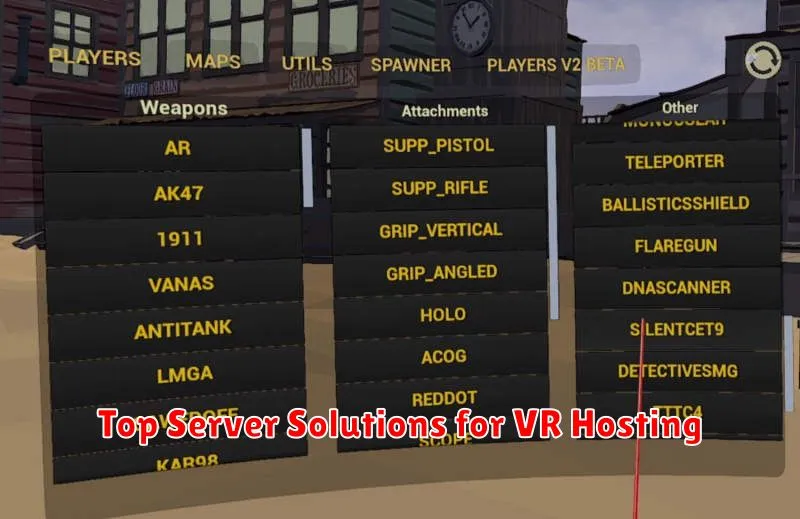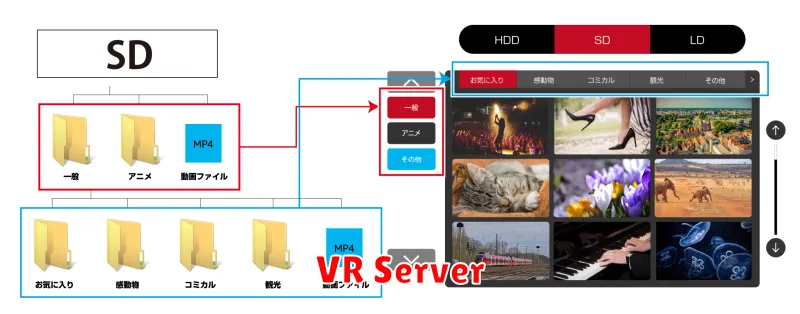If you’re looking to host virtual reality (VR) applications, choosing the right server solution is crucial for a smooth and immersive user experience. VR applications require substantial computing power, low latency, and high bandwidth to deliver realistic graphics, seamless interaction, and responsive gameplay. This article explores the best server solutions for hosting VR applications, considering factors like hardware specifications, network infrastructure, and scalability. We’ll delve into the most popular options, including dedicated servers, cloud computing platforms, and specialized VR hosting providers, to help you select the optimal solution for your needs.
The Demands of VR Applications on Servers
Virtual reality (VR) applications are becoming increasingly popular, with a wide range of use cases, from gaming and entertainment to training and education. However, VR applications are demanding on servers, requiring significant resources to deliver a smooth and immersive experience.
One of the key factors driving the demand for server resources in VR applications is the need for low latency. VR users need to experience a seamless and responsive environment, meaning that there can be little to no delay between their actions and the corresponding response in the virtual world. This requires servers with powerful processors and high bandwidth connections to handle the real-time processing and data transfer required for VR applications.
Another significant demand is the need for high bandwidth. VR applications involve transmitting large amounts of data, including 3D models, textures, and audio, to the user’s device. This data needs to be delivered at a fast rate to prevent lag and maintain the immersive experience. To achieve this, servers must have the capacity to handle large data streams efficiently.
In addition to latency and bandwidth, graphics processing power is also essential for VR applications. These applications rely on advanced graphics rendering to create realistic and immersive environments. To deliver high-quality graphics, servers need to have powerful graphics processing units (GPUs) capable of handling complex calculations and rendering scenes in real-time.
Finally, security is a crucial consideration for VR applications. Because these applications often involve sensitive data and user information, it is essential to ensure that servers are secure and protected from cyberattacks. This includes implementing robust security measures like firewalls, intrusion detection systems, and data encryption.
In conclusion, VR applications present a unique set of demands on servers. From low latency and high bandwidth to powerful GPUs and robust security measures, servers need to be equipped with the necessary resources to deliver a seamless and immersive VR experience. As VR technology continues to evolve and become more sophisticated, the demand for server resources will only continue to grow.
Processing Power and Graphics Performance
The heart of any computer, be it a desktop, laptop, or mobile device, lies in its processing power and graphics performance. These two factors, often intertwined, determine how smoothly and efficiently a device can handle tasks, from basic web browsing to demanding gaming and video editing.
Processing Power
Processing power refers to the ability of a computer’s central processing unit (CPU) to execute instructions and process data. A more powerful CPU can handle complex tasks faster, making applications and programs run smoother and more efficiently.
Graphics Performance
Graphics performance, on the other hand, is governed by the graphics processing unit (GPU). It’s responsible for rendering images and video, making the visual experience on your device richer and more immersive. A high-performance GPU is crucial for tasks like gaming, video editing, and 3D modeling.
The Interplay
While processing power and graphics performance are distinct, they often work hand in hand. For example, a powerful CPU can help to accelerate the processing of graphics data, while a dedicated GPU can offload some of the computational burden from the CPU, freeing it up to handle other tasks. This synergy ensures a smoother and more responsive overall experience.
Choosing the Right Balance
The optimal balance between processing power and graphics performance depends on your specific needs. If you’re primarily using your device for web browsing, office work, and basic multimedia, a CPU with good overall performance might be sufficient. However, if you’re a gamer or video editor, a dedicated GPU with high graphics performance is essential.
Network Latency and Bandwidth Requirements
Network latency and bandwidth are critical factors that significantly impact the performance and user experience of any online application or service. Understanding their relationship and how they affect your network is crucial for optimizing performance and ensuring a smooth and responsive experience.
Latency refers to the time delay between sending a request and receiving a response over a network. It is measured in milliseconds (ms) and represents the round-trip time for data to travel from the source to the destination and back. Lower latency is desirable, as it translates to faster response times and more interactive experiences.
Bandwidth, on the other hand, represents the amount of data that can be transmitted over a network connection in a given time period. It is typically measured in bits per second (bps) or megabits per second (Mbps). Higher bandwidth allows for faster data transfer rates, enabling smoother streaming, faster downloads, and overall improved performance.
Understanding the Impact
The relationship between latency and bandwidth is often misunderstood. While high bandwidth is important for transferring large amounts of data quickly, it doesn’t necessarily guarantee low latency. Latency is primarily influenced by factors such as the distance data travels, network congestion, and the processing power of the devices involved.
For example, a high-bandwidth connection with high latency can result in a slow and unresponsive experience, even when transferring large amounts of data. This is because the data might be transmitted quickly, but the delay in receiving responses makes the application feel sluggish.
Optimizing Network Performance
To optimize network performance, it’s important to consider both latency and bandwidth requirements. Here are some key tips:
- Choose a reliable internet service provider with low latency and adequate bandwidth for your needs.
- Use a wired connection whenever possible, as it typically offers lower latency than wireless connections.
- Minimize network congestion by avoiding heavy internet usage during peak hours or by using a VPN to reduce network traffic.
- Consider using a content delivery network (CDN) to distribute content closer to users, reducing latency and improving performance.
By understanding the impact of network latency and bandwidth, you can take steps to optimize your network and ensure a smooth and responsive experience for all your online activities.
Storage Capacity and Speed
When considering computer hardware, two important factors are storage capacity and speed. Storage capacity refers to the amount of data that can be stored on a device, while speed refers to how quickly data can be accessed and processed. These factors are crucial for various tasks, including gaming, video editing, and everyday computing.
Storage Capacity is measured in units like gigabytes (GB) and terabytes (TB). Higher capacity means more data can be stored, such as games, movies, and documents. For everyday tasks, a few hundred GB is often sufficient. However, for intensive tasks like video editing or gaming, higher capacities like 1 TB or more are recommended. Different storage types like hard disk drives (HDDs) and solid-state drives (SSDs) offer varying capacities.
Speed, on the other hand, determines how fast data can be read from and written to storage. Measured in megabytes per second (MB/s) or gigabytes per second (GB/s), faster speeds translate to quicker loading times for programs and games, faster file transfers, and smoother overall performance. SSDs generally offer much faster speeds compared to HDDs.
The ideal balance between storage capacity and speed depends on individual needs. For users with limited budget, a larger HDD might be suitable, while those prioritizing speed and responsiveness can opt for a smaller but faster SSD.
Understanding the significance of storage capacity and speed is essential for making informed decisions about computer hardware. By considering these factors, you can ensure that your computer meets your specific requirements and provides a smooth and efficient computing experience.
Cooling and Power Considerations
In the realm of electronic devices, particularly those with high-performance components, cooling and power management are paramount considerations. These factors directly influence the device’s stability, longevity, and overall performance.
Efficient cooling systems are essential to prevent overheating, which can lead to performance degradation, component failure, and even potential safety hazards. As electronic components generate heat during operation, effective heat dissipation mechanisms are crucial for maintaining optimal operating temperatures.
Power management, on the other hand, focuses on ensuring a stable and reliable power supply to the device while minimizing energy consumption. Proper power management techniques are crucial for optimizing battery life, reducing energy costs, and preventing power surges that could damage components.
Understanding the interplay between cooling and power management is essential for engineers and designers when developing electronic devices. By implementing effective strategies in these areas, they can ensure the device operates reliably, efficiently, and safely over its lifespan.
Top Server Solutions for VR Hosting

The world of virtual reality (VR) is rapidly expanding, offering immersive experiences that were once thought impossible. As VR technology continues to evolve, so too does the need for robust and reliable hosting solutions. Choosing the right server for your VR application is crucial, ensuring smooth performance and an optimal user experience. This article will explore some of the top server solutions available for VR hosting, providing valuable insights for making informed decisions.
Dedicated Servers: Unmatched Power and Control
For demanding VR applications that require high levels of performance and customization, dedicated servers are the go-to choice. These servers are physically dedicated to a single user, offering complete control over hardware resources and configurations. Dedicated servers provide exceptional processing power, ample RAM, and dedicated bandwidth, ensuring seamless VR experiences with minimal latency.
Cloud Servers: Flexibility and Scalability
Cloud servers offer a flexible and scalable alternative to dedicated servers, making them ideal for VR hosting that experiences fluctuating traffic or needs to be easily adjusted based on demand. Cloud platforms allow users to quickly provision virtual servers with varying resources and easily scale them up or down as needed. This flexibility ensures cost-effectiveness and allows for seamless growth as your VR application evolves.
VPS Hosting: A Balance of Performance and Affordability
Virtual Private Servers (VPS) provide a balance of performance and affordability, making them an attractive option for VR hosting with moderate resource requirements. VPS hosting virtualizes a physical server, providing dedicated resources and isolated environments for each user. This approach offers enhanced performance compared to shared hosting while remaining more cost-effective than dedicated servers.
Factors to Consider When Choosing a VR Hosting Solution
When selecting the best server solution for your VR hosting needs, several key factors come into play. Consider the following:
- Application Requirements: Determine the processing power, RAM, and storage capacity needed for your VR application to run smoothly.
- Traffic Levels: Anticipate your expected traffic volume and choose a server solution that can handle peak loads.
- Budget: Set a realistic budget and compare pricing options across different server types.
- Support and Maintenance: Look for providers that offer reliable customer support and proactive maintenance to ensure minimal downtime.
Conclusion
Selecting the right server solution is crucial for providing a seamless and immersive VR experience. By carefully considering the factors discussed above, you can choose the best option to meet your specific needs. Whether you opt for dedicated servers, cloud solutions, or VPS hosting, the right server can be the foundation for a successful and engaging VR journey.
